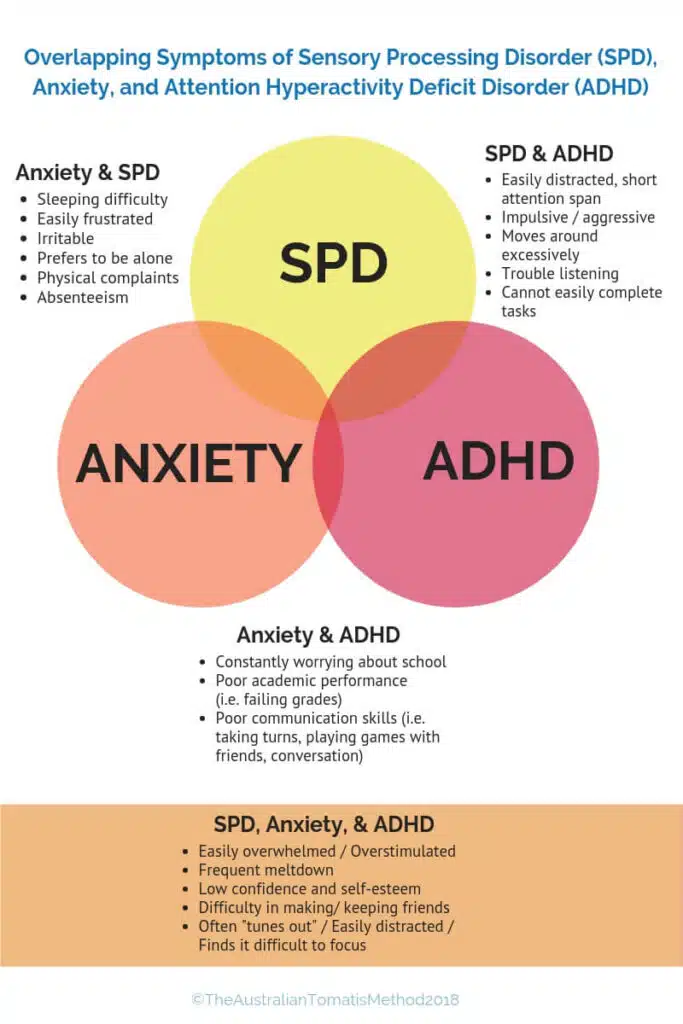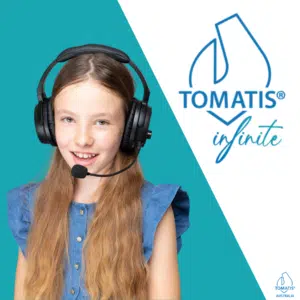Are you looking for ways to prevent sensory meltdown?
Do you want to see your child tolerate sensory experiences?
Today, this article will guide you to understand the nature of sensory processing and how to prevent sensory meltdowns.

Sensory Processing? Integration? Sensitivity? Disorder?
We fully experience the world thanks to our five senses—sight, sound, touch, taste, and smell.
These experiences are “inputs” sent to the brain for sensory processing.
Sensory processing (originally termed as sensory integration or sensory modulation) is a function of our brain to:
- receive information from our senses,
- organize and store these inputs,
- use them in our daily activities, and/or
- create behavioural responses from them.
However, some people are born with a higher level of sensitivity to their environment.
These means that they respond to external stimuli more thoroughly.
Some of them are identified as a Highly Sensitive Person (HSP) or Sensory Processing Sensitivity or Sensory Integration Deficiency.
- SPS is a neural trait.
- A survival, reasonable strategy to process information more accurately than others.
- It can lead to overstimulation
- Can also be a defense mechanism from overstimulation
On the other hand, Sensory Processing (Integration) Disorder is a brain condition that involves:
- The senses
- The vestibular system
- Proprioception (position, motion, and balance)
- Motor control
- Spatial awareness
The sensory information gets “mixed up” in the brain that results to overstimulation, uneasiness, great distress, and of course, meltdowns.
But what’s the difference of the disorder from the sensitivity?
Sensory Processing Disorder (SPD)
|
|
|
|
|
|
Sensory Processing Sensitivity (SPS)
|
|
|
|
|
Sensory processing disorder has been overlooked until now.
For many years, this was seen as symptoms of autism and is still not included in the latest edition of the DSM-5, a guide used by psychiatrists and psychologists.
“Although a sensory processing disorder is not [solely] considered as a qualifying characteristic for a diagnosis of autism, I have yet to meet a person on the autism spectrum who does not have a challenge in this area.”
~Chantal Sicile-Kira, The Autism Advocate
Adults with autism do say that sensory processing issues are the most frustrating part of their childhood.
It has impacted a lot of aspects of their lives—relationships, social interaction and communication, safety, and so on.
“It’s irritating, smothering, confusing… And you can’t just turn the triggers off.”
Here’s an example of how people with autism deal with “intense, multiple sensory (auditory) experiences at once”, also known as sensory overload.
Warning: The video contains loud, sudden noises and bright colours. May trigger sensory overload.
Video originally published on YouTube by Alkurhah
In a discussion on the co-morbidity (when two disorders exist in one person) of SPD and brain disorders, it said:
- Three quarters of children with Autism have significant symptoms of SPD
- Most children with SPD do not have Autism.
- SPD, ADHD, Autism, and Anxiety have overlapping symptoms but are all unique disorders.

In addition, a breakthrough study in 2013 revealed a biological basis for Sensory Processing Disorder (SPD) that sets it apart from other brain disorders.
Identifying the Sensory Processing Issues
One child can be very sensitive to light. Another child may want so much flavour in his/her food.
Some kids make repetitive, random noises while others scream or cry at the buzzing sound of the fridge or vacuum cleaner.
All of these could lead to a sensory meltdown.
Being able to identify your child’s unique set of sensory issues is very important in developing the plan to prevent sensory meltdowns.
Check out this non-exhaustive list of signs that your child is struggling with sensory processing issues (based on sensations).
Sense of Hearing (Auditory)
| HYPER SENSITIVE (Overwhelmed) |
HYPO SENSITIVE (Underwhelmed; Sensory-seeking) |
| Very light sleepers | Enjoys crowds, sirens, etc. |
| Gets distracted by background noise or sounds (i.e. sounds coming from vaccum cleaners, blenders, refrigerators or lights, fans, clocks, or heaters, hair or hand dryers) | Likes to stay in the noisiest places in the house (i.e. kitchen, bathroom) |
| Easily startled / distracted / frightened by sudden noises (i.e. baby crying, telephone ringing, dog barking, trains, planes) | Create sounds — tapping things, banging doors, crumpling/tearing paper, making loud rhythmic sounds using their voices |
| Hates thunderstorms and having a haircut or nails cut | Does not hear or respond to speech and verbal cues (spaces out even when name is being called) |
| Runs away / cries and/or covers ears from loud noises | Unaware to some sounds |
| May like people according to the sound of their voices | Gets confused where sounds come from |
| Refuses to go to public places like parades, movie theaters, concerts, etc. | Talks loud even when in a task |
| Fearful of common sounds at home (i.e. toilet flushing, lawn mowing, vacuum cleaning) | Easily distracted / Cannot pay attention / Frequently disoriented |
| Often seeks for a quieter place (i.e. some frequently asks people to be stop talking, laughing, etc.) | Finds it difficult to understand and remember what was said ; Needs directions/instructions repeated; Will say “What?” frequently |
| May also make repetitive noises to block out other disturbing sounds | No vocalising/babbling (during infancy) |
Sense of Sight (Vision)
| HYPER SENSITIVE (Overwhelmed) |
HYPO SENSITIVE (Underwhelmed; Sensory-seeking) |
| Easily bothered by bright lights and colours
(Covers eyes, squinting, crying, gets a headache) |
Watches everyone moving around him/her |
| Often gets watery eyes after watching TV or reading a book | Difficulty in identifying differences between printed letters, pictures, objects, symbols, and figures (similar to dyslexia and dyscalculia) |
| Enjoys playing in dark areas of the house | Focuses on details instead of the bigger picture |
| Avoids eye contact | Poor control over eye movement especially when tracking and following moving objects |
| Easily distracted and irritated with visual movement (i.e. doors, windows, toys, hanging decors etc.) | Loses place when doing visual tasks (i.e. reading, solving math problems, copying from a book) |
| Difficulty with focusing on tasks and will need a lot more time | Poor sense of space and location (i.e. confuses left and right, bumps into things, missteps stairs and curbs) |
| Difficulty with copying shapes, cutting, tracing along lines, and jigsaw puzzles |
Sense of Touch (Tactile)
| HYPER SENSITIVE (Overwhelmed) |
HYPO SENSITIVE (Underwhelmed; Sensory-seeking) |
| Gets anxious, scared, and/or aggressive with light, unexpected touch; Finds it difficult to stand close to other people | Seeks movements that often disrupt daily activities (i.e. fidgeting, can’t sit still, running around) |
| Get distressed during grooming (i.e. hair cutting, nail clipping, teeth brushing, face washing) | Feels the need to touch everything and everyone |
| Excessively ticklish; Avoid being barefoot or in contact with sand, grass, mud, water, playdoh, slime, etc. | May be self-injurious or self-abusive (i.e. biting, pinching, cutting, head-banging); usually shows no distress with shots, cuts, and bruises (high pain tolerance) |
| Refuses to wear clothes with certain textures; dislikes seams of socks or pants (may vary according to child’s unique preferences) | May frequently hurt other children or pets while playing |
| Gets distressed with dirty hands; avoids “messy” play | Enjoys and seeks out messy play but may also not be aware that hands/face/feet are dirty |
| Picky eater – only likes certain tastes and textures; resists trying new food | Chews, bites, or “mouths” on objects excessively |
| Often prefers hugs than kisses; some hates being held or cuddled at all | Prefers excessively spicy, sweet, sour, or salty foods |
| Dislikes certain textures of material (i.e. blankets, fur of stuff animals, rugs, socks, etc.) | Craves vibrating objects or objects that provide strong sensory input |
| Overreacts to minor cuts, scrapes, and bug bites | Interrupted play – jumps from one activity to another |
With a comprehensive list of your child’s sensory needs, you can work efficiently with your child’s GP, therapist/s and teachers.
Get Professional Support
A child or adult with sensory processing disorder can get help from these experts:
Occupational Therapist
- Tailor physical activities to regulate sensory input
- Find different ways of doing tasks
- Makes use of tools to perform activities easier
-
- May evaluate learning and emotion issues related to sensory processing disorder
- Apply therapies to enable kids to manage their actions and interactions
Developmental-behavioural pediatrician
-
- Can prescribe medication for stress, anxiety, and other concerns
Use Sensory Tools and Therapies
**Notice of Non-Affiliation: We are not affiliated, associated, or in any way connected with most of the companies below.
There is no magic wand for any brain disorder. But you have the options, tools, therapies and resources that can help prevent sensory meltdowns.
- Sensory Integration Therapy – a sensory stimulation through physical activities structured in a repetitive way
- Tomatis® Method – a natural approach to neurosensory stimulation. Its listening programs change the music and voice in real time in order to capture the brain’s attention and to develop motor, emotional and cognitive skills
- Cognitive Behavioural Therapy – a short-term, goal-oriented psychotherapy treatment that takes a hands-on, practical approach to problem-solving
- Forbrain® – trains the brain to be more attentive improving not only attention but auditory processing and sensory integration
- Sensory Toys Stores (in Australia and US)
- Senseabilities
- Sensory Oasis for Kids
- Sister Sensory Child Sensory Solutions
- Apps
- BrainWorks
- See.Touch.Learn
- Fluidity HD
- StoryBuilder
- Pocket Pond
- Dropophone
- Modus
- Going Places
“…The reality is that in the heat of the moment you feel overwhelmed with emotions, helpless, and even a sense of why us? why me? But there’s no sense in dwelling. The reality is that this is now my reality and I have to be prepared for it whenever it decides to come.” ~Elina, a mom of a kid with SPD
The impacts and results of these tools and therapies vary on every child. Nevertheless, you have the choice to do what is best and what works for your child.
How do you deal with your child’s sensory meltdowns? Comment below!
Françoise Nicoloff
Official Representative of Tomatis Developpement SA in Australia, Asia and South Pacific, Director of the Australian Tomatis® Method, Registered Psychologist, Certified Tomatis® Consultant Senior, Tomatis® International Trainer and Speaker, Co-author of the Listening Journey Series, 40 Years of Experience, Neurodiversity Speaker



